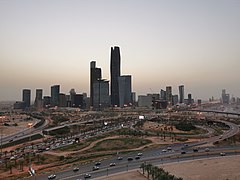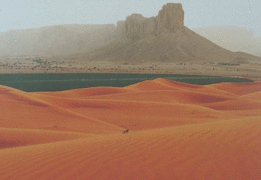Riyadh
Riyadh
الرياض | |
|---|---|
|
GDP (PPP, constant 2015 values) | |
| • Year | 2023 |
| • Total | $428.7 billion[3] |
| • Per capita | $55,800 |
| Time zone | UTC+03:00 (AST) |
| Postal Code | (5 digits) |
| Area code | +966 011 |
| HDI (2021) | 0.900[4] – very high |
| Website | alriyadh.gov.sa |

Riyadh (
It is the
The first mention of the city by the name Riyadh was in 1590, by an Arab chronicler.
Riyadh is the political and administrative center of Saudi Arabia. The Consultative Assembly (also known as the Shura or Shura Council), the Council of Ministers, the King and the Supreme Judicial Council are all situated in the city. Alongside these four bodies that form the core of the legal system of Saudi Arabia, the headquarters of other major and minor governmental bodies are also located in Riyadh.[13] The city hosts 114 foreign embassies, most of which are located in the Diplomatic Quarter in the western reaches of the city.
Riyadh also holds
The city is divided into 15 municipal districts, which are overseen by the
History
Early history
During the
.Later on,
Commodities
The capital of Saudi Arabia, Riyadh, was initially known for its availability of water and fertile land which made it ideal for farming dates and other crops. Dates are abundant in the Middle East due to the perfect environment for the date palms. Wheat has also been a big commodity, however, there have been issues with it. There have been issues with insects and mites infesting the wheat supply in Saudi Arabia. However, a few years ago, Riyadh decided to reduce its wheat gathering. Riyadh was then designated as the capital and the layout of the city changed, focusing more on city development in the mid-1900s. As the city developed, the commodities changed slightly. Almost one-third of Saudi Arabia’s factories are located in Riyadh, producing a range of products including machinery, equipment, metallurgical goods, chemicals, construction materials, food, textiles, furniture, and numerous publications.[19] While food is still part of Riyadh's commodities. It has developed to steer toward more urban commodities and those veered to city life.
First Saudi State

In 1750,
The First Saudi State was destroyed by forces sent by
Following the death of Faisal, there was rivalry among his sons which situation was exploited by
Internecine struggles between Turki's grandsons led to the fall of the Second Saudi State in 1891 at the hand of the rival
Abdul Rahman bin Faisal al-Saud had sought refuge among a tribal community on the outskirts of Najd and then went to Kuwait with his family and stayed in exile. However, his son Abdul Aziz retrieved his ancestral kingdom of Najd in 1902 and consolidated his rule by 1926, and further expanded his kingdom to cover "most of the Arabian Peninsula."[11] He named his kingdom as Saudi Arabia in September 1932[11] with Riyadh as the capital.[12] King Abdul Aziz died in 1953 and his son Saud took control as per the established succession rule of father to son from the time Muhammad bin Saud had established the Saud rule in 1744. However, this established line of succession was broken when King Saud was succeeded by his brother King Faisal in 1964. In 1975, Faisal was succeeded by his brother King Khalid. In 1982, King Fahd took the reins from his brother. This new line of succession is among the sons of King Abdul Aziz who has 35 sons; this large family of Ibn Saud hold all key positions in the large kingdom.[11]
Modern history
From the 1940s, Riyadh mushroomed from a relatively narrow, spatially isolated town into a spacious metropolis.[22] When King Saud came to power, he made it his objective to modernize Riyadh, and began developing Annasriyyah, the royal residential district, in 1950.[22] Following the example of American cities, new settlements and entire neighborhoods were created on grid plans, and connected by high-capacity main roads to the inner areas. The grid pattern in the city was introduced in 1953.[22] The population growth of the town from 1974 to 1992 averaged 8.2 percent per year.
On 16 November 1983,
Al-Qaeda under Osama bin Laden launched coordinated attacks on compounds in Riyadh on 12 May 2003, resulting in the deaths of 39 people. The bombings were considered to be a terrorism campaign against Western influence in Saudi Arabia.
The mayor is Prince Faisal bin Abdulaziz al-Muqrin. Al-Muqrin was appointed in 2019 by royal decree
According to the Global Financial Centres Index, Riyadh ranked at 77 in 2016–2017. Though the rank moved up to 69 in 2018, diversification in the economy of the capital is required in order to avoid what the World Bank called a "looming poverty crisis" brought on by lingering low oil prices and rich state benefits.[27]
Since 2017, Riyadh has been the target of missiles from Yemen.
A restoration of heritage buildings of historical significance was launched in Riyadh by Crown Prince Mohammed bin Salman on 13 September 2020.
-
Lake at the 120 km long Wadi Hanifa valley that cuts through Riyadh
-
King Abdullah Financial District
-
TheAn Nafud desert on the outskirts of Riyadh with the Jabal Tuwaiqin the background
Geography
Climate
Riyadh has a
| Climate data for Riyadh (1991-2020) | |||||||||||||
|---|---|---|---|---|---|---|---|---|---|---|---|---|---|
| Month | Jan | Feb | Mar | Apr | May | Jun | Jul | Aug | Sep | Oct | Nov | Dec | Year |
| Record high °C (°F) | 33.0 (91.4) |
35.0 (95.0) |
38.0 (100.4) |
42.0 (107.6) |
46.0 (114.8) |
47.5 (117.5) |
48.4 (119.1) |
49.8 (121.6) |
46.8 (116.2) |
42.5 (108.5) |
38.0 (100.4) |
32.7 (90.9) |
49.8 (121.6) |
| Mean daily maximum °C (°F) | 20.7 (69.3) |
23.7 (74.7) |
28.0 (82.4) |
33.6 (92.5) |
39.5 (103.1) |
42.8 (109.0) |
43.9 (111.0) |
43.8 (110.8) |
40.9 (105.6) |
35.5 (95.9) |
27.4 (81.3) |
22.3 (72.1) |
33.5 (92.3) |
| Daily mean °C (°F) | 14.0 (57.2) |
16.7 (62.1) |
21.0 (69.8) |
26.4 (79.5) |
32.2 (90.0) |
35.2 (95.4) |
36.3 (97.3) |
36.0 (96.8) |
32.8 (91.0) |
27.5 (81.5) |
20.4 (68.7) |
15.4 (59.7) |
26.2 (79.1) |
| Mean daily minimum °C (°F) | 7.6 (45.7) |
9.9 (49.8) |
13.8 (56.8) |
19.1 (66.4) |
24.1 (75.4) |
26.1 (79.0) |
27.3 (81.1) |
27.0 (80.6) |
23.7 (74.7) |
18.9 (66.0) |
13.6 (56.5) |
9.1 (48.4) |
18.3 (65.0) |
| Record low °C (°F) | −5.4 (22.3) |
−3.3 (26.1) |
2.1 (35.8) |
8.9 (48.0) |
14.0 (57.2) |
19.8 (67.6) |
20.0 (68.0) |
20.0 (68.0) |
14.4 (57.9) |
8.9 (48.0) |
4.5 (40.1) |
−2.0 (28.4) |
−5.4 (22.3) |
| Average precipitation mm (inches) | 14.8 (0.58) |
8.3 (0.33) |
19.9 (0.78) |
23.7 (0.93) |
5.7 (0.22) |
0.0 (0.0) |
0.0 (0.0) |
0.0 (0.0) |
0.0 (0.0) |
1.5 (0.06) |
20.1 (0.79) |
13.5 (0.53) |
107.6 (4.24) |
| Average precipitation days (≥ 1.0 mm) | 1.7 | 1.5 | 2.6 | 3.7 | 0.9 | 0.0 | 0.0 | 0.0 | 0.0 | 0.4 | 2.5 | 1.7 | 14.9 |
| Average relative humidity (%)
|
47 | 36 | 32 | 28 | 17 | 11 | 10 | 12 | 14 | 20 | 36 | 47 | 26 |
| Average dew point °C (°F) | 2 (36) |
1 (34) |
2 (36) |
4 (39) |
3 (37) |
−1 (30) |
0 (32) |
2 (36) |
2 (36) |
2 (36) |
4 (39) |
3 (37) |
2 (36) |
| Mean monthly sunshine hours | 212.4 | 226.6 | 219.8 | 242.3 | 287.7 | 328.2 | 332.1 | 309.2 | 271.6 | 311.4 | 269.2 | 214.3 | 3,224.8 |
| Percent possible sunshine | 63 | 71 | 59 | 63 | 70 | 80 | 80 | 77 | 74 | 87 | 82 | 65 | 72 |
| Average ultraviolet index | 3 | 7 | 9 | 11 | 12 | 22 | 20 | 18 | 11 | 8 | 6 | 0 | 11 |
| Source 1: | |||||||||||||
| Source 2: Time and Date (dewpoints, 1985-2015)[35] | |||||||||||||
City districts
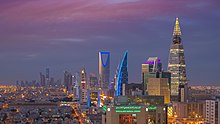
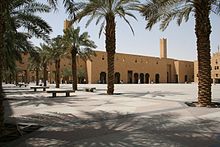
Riyadh is divided into fourteen branch municipalities,
Some of the main districts of Riyadh are:
- Al-Bat'ha[38]
- Al-Deerah (old Riyadh)
- Mi'kal
- Manfuha
- Manfuha Al-Jadidah (منفوحة الجديدة – "new Manfuha")
- Al-'Oud
- Al-Mansorah
- Al-Margab
- Salam
- Jabrah
- Al-Yamamah
- 'Otayyigah
- Al-'Olayya & Sulaymaniyyah[39]
- Al-'Olayya
- Al-Sulaymaniyyah
- Al Izdihar
- King Fahd District
- Al-Masif
- Al-Murooj
- Al-Mugharrazat
- Al-Wurood
- Nemar[38]
- Nemar
- Dharat Nemar
- Tuwaiq
- Hazm
- Deerab
- Irqah[36]
- Irqah
- Al-Khozama
- Diplomatic Quarter
- Al-Shemaysi[40]
- Al-Shemaysi
- Eleyshah
- Al-Badi'ah
- Syah
- Al-Nasriyyah
- Umm Sleym
- Al-Ma'athar
- Umm Al-Hamam (East)
- Al-Ma'athar[41]
- Al-Olayya
- Al-Nakheel
- King Saud University main campus
- Umm Al-Hamam (East)
- Umm Al-Hamam (West)
- Al-Ma'athar Al-Shimali ("North Ma'athar")
- Al-Rahmaniyya
- Al-Muhammadiyya
- Al-Ra'id
- Al-Ha'ir[36]
- Al-Ha'ir
- Al-Ghannamiyyah
- Uraydh
- Al-'Aziziyyah[42]
- Al Aziziyah (Riyadh)
- Ad Dar Al Baida
- Taybah
- Al Mansouriyah
- Al-Malaz[43]
- Al-Malaz
- Al-Rabwah
- Al-Rayyan
- Jarir
- Al-Murabba'
- Sinaiyah Qadeem
- Al-Shifa[44]
- Al-Masani'
- Al-Shifa
- Al-Mansuriyya
- Al-Marwah
- Al-Urayja[45]
- Al-Urayja
- Al-Urayja Al-Wusta ("Mid-Urayja")
- Al-Urayja (West)
- Shubra
- Dharat Laban
- Hijrat Laban
- As-Suwaidi
- As-Suwaidi (West)
- Dahrat Al-Badi'ah
- Sultanah
- Al-Shemal[46]
- Al-Malga
- Al-Sahafa
- Hittin
- Al-Wadi
- Al-Ghadir
- Al-Nafil
- Imam Muhammad ibn Saud Universitymain campus
- Al-Qayrawan
- Al-Aqiq
- Al-Arid
- Al-Naseem[47]
- Al-Naseem (East)
- Al-Naseem (West)
- As-Salam
- Al-Manar
- Al-Rimayah
- Al-Nadheem
- Al-Rawdhah[36]
- Al-Rawdhah
- Al-Qadisiyah
- Al-M'aizliyyah
- Al-Nahdhah
- Gharnatah (Granada)
- Qortubah (Cordoba)
- Al-Andalus (Andalusia)
- Al-Hamra
- Al-Qouds
- Al-Selayy[48]
- Al-Selayy
- Ad Difa'
- Al Iskan
- Khashm Al-'Aan
- Al-Sa'adah
- Al-Fayha
- Al-Manakh
- King Abdullah Financial District
- Diriyah (suburb of Riyadh)
Demographics

| Year | Pop. | ±% p.a. |
|---|---|---|
| 1918 | 18,000 | — |
| 1924 | 30,000 | +8.89% |
| 1944 | 50,000 | +2.59% |
| 1952 | 80,000 | +6.05% |
| 1960 | 150,000 | +8.17% |
| 1972 | 500,000 | +10.55% |
| 1978 | 760,000 | +7.23% |
| 1987 | 1,389,000 | +6.93% |
| 1992 | 3,834,986 | +22.52% |
| 1997 | 3,100,000 | −4.17% |
| 2004 | 4,138,329 | +4.21% |
| 2009 | 4,873,723 | +3.33% |
| 2010 | 6,792,776 | +39.38% |
| 2013 | 5,899,528 | −4.59% |
| 2016 | 6,506,700 | +3.32% |
| 2017 | 7,676,654 | +17.98% |
| Source: Census data, [49][citation needed] | ||
In 2022, the city had over 7 million people.
Landmarks and architecture
Vernacular architecture of Old Riyadh
The old town of Riyadh within the
Expansion outside the
There are other traditional villages and towns in the area around traditional Riyadh which the
- Ain Heet Cave
Ain Heet cave has an underground lake (150 meters deep) situated at the face of Mount Al Jubayl in Wadi As Sulay in a small village called Heet in Riyadh. Between Riyadh and Al Kharj road, it is one of the easily accessible caves in the area of Riyadh.
Archeological sites

The archeological sites at Riyadh which are of historical importance, in which the Municipality of Riyadh is involved, are the five old gates on the old walls of Riyadh. These are the eastern gate of Thumaira, the northern gate of Al-Suwailen, the southern gate of Dukhna, the western gate of Al-Madhbah, and the south-western gate of Shumaisi. There are also four historic palaces:
Turaif district
The
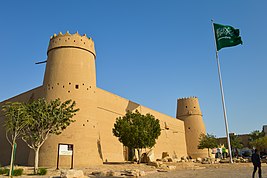
Masmak Fortress
This fortress was built around 1865 under the reign of
Contemporary architecture
Kingdom Centre
Designed by the team of
The Kingdom Tower has 99 stories and is the fifth tallest structure in the country, rising to 300 m. A special aspect of the tower is that it is divided into two parts in the last one-third of its height and is linked by a sky-bridge walkway, which provides extensive views of Riyadh.[59]
Burj Rafal Hotel Kempinski
Burj Rafal, located on King Fahd Road, is the tallest skyscraper in Riyadh at 307.9 meters (1,010 feet) tall. The tower was designed and engineered by P & T Group. Construction began in 2010 and was completed in 2014. The project was considered a success, with 70% of the residential units already sold by the time the skyscraper was topped out. The tower contains 474 residential condominium units and a 349-room 5-star Kempinski hotel.[60]
Burj Al Faisaliyah
Al Faisaliyah Centre (Arabic: برج الفيصلية) is the first skyscraper constructed in Saudi Arabia and is the third tallest building in Riyadh after the Burj Rafal and the Kingdom Centre. The golden ball that lies atop the tower is said to be inspired by a ballpoint pen, and contains a restaurant; immediately below this is an outside viewing deck. There is a shopping center with major world brands at ground level. Al Faisaliyah Centre also has a hotel on both sides of the tower while the main building is occupied by office. The Al Faisaliyah Tower has 44 stories.[59] It was designed by Foster and Partners.
Riyadh TV Tower
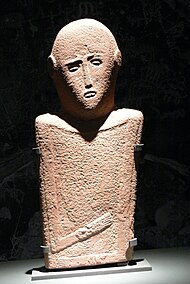
The Riyadh TV Tower is a 170 meter high television tower located inside the premises of the Saudi Ministry of Information. It is a vertical cantilever structure which was built between 1978 and 1981. The first movie made in 1983 by the TV tower group and named "1,000 Nights and Night" had Mohammed Abdu and Talal Mmdah as the main characters. At that time, there were no women on TV because of religious restrictions. Three years later, Abdul Khaliq Al-Ghanim produced a TV series called "Tash Ma Tash," which earned a good reaction from audiences in Eastern Arabia. This series created a media revolution back in the 1980s.[61]
Museums and collections
In 1999, a new central museum was built in Riyadh, at the eastern side of the
The Royal Saudi Air Force Museum, or Saqr Al-Jazira, is located on the East Ring Road of Riyadh between exits 10 and 11. It contains a collection of aircraft and aviation-related items used by the Royal Saudi Air Force and Saudia (Saudi Arabian Airlines).
Sports
The city also has several large stadiums such as
The city's
On 29 February 2020, the world's richest thoroughbred horse race took place at the King Abdulaziz Racetrack in Riyadh. The Saudi Cup is a new race for thoroughbreds aged four and up, to be run at weight-for-age terms over 1800m (9f). The prize money is US$20m with a prize of US$10m to the winner and prize money down to tenth place. The Saudi Cup is perfectly positioned between the Pegasus World Cup and the Dubai World Cup to attract the best horses from around the world to compete for horse racing's richest prize. Putting the Kingdom of Saudi Arabia on the international horseracing map, the Saudi Cup will also hold an undercard of international races on both dirt and the new turf course.
On 26 April 2020, Saudi Arabia entered the bidding process for the 2030 Asian Games; their main rival for this event was Doha, Qatar. On 16 December 2020, it was announced that Riyadh will host the 2034 Asian Games.[66][67]
Esports in Riyadh began its journey with the city's first major tournament, the GSA E-Sports Cup, in 2018. The Saudi Esports Federation further boosted this growth by organizing the Gamers8 festival in 2022 and 2023. The 2023 edition of the festival offered the largest prize pool in the history of global competitive esports, totaling $45 million. As part of the Gamers8 festival, the Riyadh Masters, a Dota 2 tournament, boasted a significant prize pool of $15 million, surpassed only by the Fortnite World Cup Finals and The International in the history of esports tournaments.[citation needed]
Transportation
Air

Riyadh's King Khalid International Airport (KKIA) is located 35 kilometers north of the city center. It is the city's main airport, and served over 20 million passengers in 2013.[68] The airport will be expanded into a huge airport, with six parallel runways and three or four large passenger terminals by 2030. It will be able to serve 120 million passengers per year after 2030, and 185 million passengers per year by 2050.[69][70]
Buses
The metro system will be integrated with an 85 kilometers (53 mi), three-line bus rapid transit (BRT) network.[71]
The main charter bus company in the kingdom, known as the Saudi Public Transport Company (SAPTCO), offers trips both within the kingdom and to its neighboring countries, including Egypt (via ferries from Safaga or Nuweiba) and Arab states of the Gulf Cooperation Council.[72]
Metro
The six line Riyadh Metro is currently under construction. The first line was expected to open by end of 2021,[73][74] but is now expected to open in 2024.
Railways
Roads

The city is served by a major highway system. The main Eastern Ring Road connects the city's south and north, while the Northern Ring Road connects the city's east and west. King Fahd Road runs through the center of the city from north to south,[76] in parallel with the East Ring Road. Makkah Road, which runs east–west across the city's center, connects eastern parts of the city with the city's main business district and the diplomatic quarters.
Media
The 170 m (560 ft) Riyadh TV Tower, operated by the Ministry of Information, was built between 1978 and 1981. National Saudi television channels Saudi TV1, Saudi TV2,
Development projects

In 2019, King Salman launched a plan to implement 1281[78] development projects in Riyadh. The project is planned to cost around US$22 billion.[79] The main goal of the plan is to improve the infrastructure, transportation, environment and other facilities in Riyadh and the surrounding area.[79] In the framework of Saudi Vision 2030, the plan will take care of constructing 15 housing projects, building a huge museum, establishing an environmental project, sports areas, medical cities, educational facilities, etc.[79] This includes the establishment of 14 electricity projects,[80] 20 sewage projects, 10 housing areas, 66 trading and industrial areas, a number of lakes covering 315,000 square meters, and advanced sports cities.[78] Since the announcment of the Vision, Riyadh has implemented various reforms to lay the foundation for the next steps of the Vision. [81]
Alongside the development project and in the aim of enhancing the artistic movement of the city, 1000 pieces of art are planned to be publicly displayed in the city by the end of 2030.[82] In the framework of Riyadh's development projects, an amount of SR 604 million has been awarded to develop and construct roads of Riyadh.[83] On 3 July 2020, Bloomberg reported that Saudi Arabia has allocated $20 billion on the mega-project of tourism and culture in Riyadh namely, "Diriyah Gate", while facing a double economic crisis after rise in coronavirus cases.[84]
The Ministry of Investment and the Royal Commission for Riyadh City (RCRC) announced on 13 July 2021 that they have partnered with SEK Education Group to open SEK International School Riyadh, its first campus in Saudi Arabia. The new international school will welcome students from Pre-K (age 3 years) to Grade 12 (age 17/18 years), and will become one of the few schools in Riyadh accredited to offer the International Baccalaureate (IB) Primary Years Programme (PYP), Middle Years Programme (MYP), and Diploma Programme (DP).
Events and festivals
Jenadriyah
Jenadriyah is an annual festival that has been held in Riyadh. It hosts a number of cultural and traditional events, such as camel race, poetry reading and others.[85]
Riyadh International Book Fair
It is one of the largest book fairs in the MENA region. It is usually held between March and April and it hosts a wide range of Saudi, Arab and international publishers.[86]
Riyadh Season
In the framework of the recent Saudi endeavor to promote tourism in the country, Riyadh Season was held as part of the Saudi Seasons initiative. The season took place in October 2019 and lasted until December 2019. It hosted a wide range of sports, musical, theatrical, fashion shows, circus, and various other entertainment activities.[87] Some of Riyadh Season events are BTS concert, Joy convention and Joy Expo, Ice Rink, WWE Events, Arabian concerts, Egyptian Theater, League of Legends, Real Madrid Interactive Expo and Ferrari Festival.[88]
Noor Riyadh
Noor Riyadh (Noor meaning light in Arabic) is an annual festival and one of the four major projects under the mandate of the Royal Commission for Riyadh City. It is the festival of light and art. In 2021, the festival will be launched on 18 March and will last until 3 April.[89]
References
- ^ "Elevation Finder". www.freemaptools.com. Retrieved 14 May 2021.
- ^ "بوابة الهيئة - الصفحة الرئيسية". portal.saudicensus.sa (in Arabic).
- ^ "TelluBase—Saudi Arabia Fact Sheet (Tellusant Public Service Series)" (PDF). tellusant.com. Tellusant, Inc. Retrieved 11 January 2024.
- ^ "Sub-national HDI – Subnational HDI – Global Data Lab".
- ^ "Riyadh". Merriam-Webster.com Dictionary.
- ^ Gardham, Richard (28 December 2022). "The largest cities in Saudi Arabia (and their investment strengths)". Investment Monitor. Retrieved 16 April 2023.
- ^ "Geographic Location of Riyadh". Riyadh Development Authority. 8 December 2018. Retrieved 24 May 2019.
- ^ "هيئة تطوير مدينة الرياض توافق على طلبات مطورين لإنشاء 4 مشاريع سياحية وترفيهية" (in Arabic). 4 April 2019. Archived from the original on 4 April 2019. Retrieved 24 May 2019.
- ^ a b c d Cybriwsky 2013, p. 258.
- ^ a b Al-Oteibi 1993, p. 163.
- ^ a b c d e Farsy 1990, p. 15.
- ^ a b Facey 1992, p. 271.
- ^ Moon, Carol. "LibGuides: A Guide to Saudi Arabia Politics: 1.Government of Saudi Arabia". slulibrary.saintleo.edu. Retrieved 25 July 2020.
- ^ "Prince Faisal bin Abdulaziz appointed as Riyadh mayor by royal decree". Arab News. 26 November 2019. Retrieved 25 July 2020.
- ^ "Saudi capital Riyadh to host World Expo 2030". Arab News. 28 November 2023. Retrieved 28 November 2023.
- ^ "Saudi Arabia to Host World Expo 2030, in Victory for Crown Prince". the newyork times.com. 28 November 2023. Retrieved 29 November 2023.
- ^ Sonbol 2012, p. 99.
- ^ "al-hakawati - Riyadh". al-hakawati.net. Retrieved 16 April 2023.
- ^ U4SSC. "Riyadh, Saudi Arabia factsheet" (PDF).
{{cite web}}: CS1 maint: numeric names: authors list (link) - ^ a b c d Farsy 1990, p. 14.
- ^ ISBN 978-1-902339-00-9.
- ^ a b c Elsheshtawy 2008, p. 124.
- ^ "Prince Faisal bin Abdulaziz appointed as Riyadh mayor by royal decree". Arab News. 27 November 2019.
- ^ Mueller, H. E.; Williams, A. D. (4 April 2016). Saudi Real Estate Companion: Essential Real Estate Skills for the Saudi Arabian Market. Booktango.
- ^ Bhatia, Neha (15 February 2017). "Interserve MENA chief hopeful of Saudi FM's growth | ConstructionWeekOnline.com". Construction Week Online. Retrieved 30 May 2017.
- ^ Miller, David (13 March 2011). "Saudi Arabia opens world's largest women's university". The Jerusalem Post. Retrieved 17 January 2012.
- ^ "Saudi Arabia is stumbling in its efforts to build a global financial center". CNBC. 21 August 2018. Retrieved 21 August 2018.
- ^ Almosawa, Shuaib; Barnard, Anna (4 November 2017). "Saudis Intercept Missile Fired From Yemen That Came Close to Riyadh". The New York Times. United States. Retrieved 9 May 2018.
"Yemeni rebel ballistic missile targeting Riyadh intercepted, Saudi forces say". CBS News. United States. Associated Press. 11 April 2018. Retrieved 9 May 2018. - ^ "Saudi Arabia: Houthi missile attack kills Egyptian in Riyadh". Al Jazeera. Qatar. 26 March 2018. Retrieved 9 May 2018.
- ^ "Loud booms in Saudi Arabia's capital as military intercepts missiles from Yemen: report". Fox News. United States. Associated Press. 9 May 2018. Retrieved 9 May 2018.
- ^ "Saudi forces shoot down 'toy drone' near royal palace". Al Jazeera. 21 April 2018. Retrieved 23 May 2018.
Fahim, Kareem; Morris, Loveday (21 May 2018). "After rare gunfire in Saudi capital, officials say they shot down a toy drone". The Washington Post. Retrieved 23 May 2018.
El Gamal, Rania; Kalin, Stephen (21 April 2018). "Saudi security shoots down recreational drone near royal palace". Reuters. Retrieved 23 May 2018. - ^ Sheth, Sonam; Mark, Michelle (22 April 2018). "Confusion erupts after a 'small, drone-type' object was apparently shot down near the king's palace in Saudi Arabia". Business Insider. Retrieved 23 May 2018.
Aldroubi, Mina (22 April 2018). "Saudi Arabia dismisses rumours of coup attempt". The National. Retrieved 23 May 2018.
Specia, Megan (21 April 2018). "Saudi Arabia Says Toy Drone Shot Down in Capital Riyadh". The New York Times. Retrieved 23 May 2018. - National centers for Environmental Information. Retrieved 2 August 2023.
- ^ "Climate Data for Saudi Arabia". Jeddah Regional Climate Center. Archived from the original on 12 May 2012. Retrieved 29 October 2015.
- ^ "Climate & Weather Averages in Riyadh, Saudi Arabia". Time and Date. Retrieved 11 January 2022.
- ^ a b c d "Interactive Map of Riyadh's branch municipalities" (in Arabic). Riyadh Municipal Government.
- ^ MEED. Economic East Economic Digest, Limited. 2004. p. 4.
- ^ a b "Al-Bat'ha". Riyadh Municipal Government. Archived from the original on 19 December 2007. Retrieved 26 March 2011.
- ^ "Nemar". Riyadh Municipal Government. Archived from the original on 17 March 2011. Retrieved 26 March 2011.
- ^ "Al-Shemaysi". Riyadh Municipal Government. Retrieved 26 March 2011.[permanent dead link]
- ^ "Al-Ma'athar". Riyadh Municipal Government. Retrieved 26 March 2011.
- ^ "Al-Aziziyya". Riyadh Municipal Government. Retrieved 26 March 2011.
- ^ "Al-Malaz". Riyadh Municipal Government. Archived from the original on 19 December 2007. Retrieved 26 March 2011.
- ^ "Al-Shifa". Riyadh Municipal Government. Retrieved 26 March 2011.
- ^ "Al-'Urayja". Riyadh Municipal Government. Retrieved 26 March 2011.[permanent dead link]
- ^ "Al-Shemal". Riyadh Municipal Government. Retrieved 26 March 2011.
- ^ "Al-Naseem". Riyadh Municipal Government. Archived from the original on 17 May 2007. Retrieved 26 March 2011.
- ^ "Al-Selayy". Riyadh Municipal Government. Retrieved 26 March 2011.
- ^ GASTAT (17 December 2015). "2010 Census, 1992 Census". The General Authority for Statistics.
- ^ USGS. [Riyadh, Saudi Arabia Earth Resources Observation and Science (EROS) Center - Earthshots "Riyadh, Saudi Arabia Earth Resources Observation and Science (EROS) Center - Earthshots"].
{{cite web}}: Check|url=value (help) - ^ Elsheshtawy 2008, p. 122.
- ^ "Riyadh City". Saudi Arabia- Ministry of Interior. Archived from the original on 27 March 2017. Retrieved 25 May 2019.
- ^ "SCTH - default". scta.gov.sa. Archived from the original on 27 December 2017. Retrieved 16 January 2014.
- ^ Farsy 1990, p. 22.
- ^ "At-Turaif District in ad-Dir'iyah". UNESCO World Heritage Centre. Retrieved 5 May 2019.
- ^ "Turaif District". www.sauditourism.sa. Archived from the original on 5 May 2019. Retrieved 5 May 2019.
- ^ "Al-Turaif: How Saudi Arabia is bolstering future tourism by reviving past treasures". Arab News. 11 December 2018. Retrieved 5 May 2019.
- ^ "Turaif Quarter - World Heritage Site - Pictures, Info and Travel Reports". www.worldheritagesite.org. Retrieved 5 May 2019.
- ^ a b Jordan 2011, p. 98.
- ^ "Burj Rafal". The Skyscraper Center. Retrieved 14 August 2018.
- ^ "Riyadh Television Tower". Structurae.net. Retrieved 19 January 2014.
- ^ "Al Hilal (Riyadh)". Soccerway.com. Retrieved 22 November 2013.
- ^ ar:دوري المحترفين السعودي#Ù.82ائÙ.85ة اÙ.84أبطاÙ.84
- ^ "Al-Nassr Football Club". eyeofriyadh.com. Retrieved 15 September 2020.
- ^ a b c "Sports". Riyadh.com. Retrieved 22 November 2013.
- ^ "Doha to host 2030 Asian Games, Riyadh 2034 edition". Channel News Asia. AFP. 16 December 2020. Archived from the original on 11 May 2021. Retrieved 16 December 2020.
- ^ "Doha to host 2030 Asian Games with Riyadh awarded 2034 edition". www.insidethegames.biz. 16 December 2020. Retrieved 16 December 2020.
- ^ "Expansion to up Riyadh airport capacity to 35 m". Arab News. Retrieved 24 November 2013.
- ^ "Saudi Arabia plans one of the world's biggest airports". CNN. 2 December 2022. Retrieved 10 January 2023.
- ^ "Crown Prince launches master plan for Riyadh's King Salman International Airport". Al Arabiya. 28 November 2022. Retrieved 10 January 2023.
- ^ DVV Media UK. "Four consortia prequalify for Riyadh metro contract". Railway Gazette. Archived from the original on 24 May 2013. Retrieved 5 August 2012.
- ^ "SAPTCO - الرئيسية". saptco.com.sa. Archived from the original on 21 September 2015. Retrieved 4 August 2015.
- ^ "Four consortia prequalify for Riyadh metro contract". Railway Gazette International. 3 August 2012. Archived from the original on 24 May 2013. Retrieved 5 August 2012.
- ^ "Look: Saudi Arabia's Riyadh Metro project first lines set to open in mid-2021". Gulf News. 4 April 2021. Retrieved 29 June 2021.
- ^ "Makkah-Madinah train set to roll by January 2014". Arab News. Retrieved 24 November 2013.
- ^ Ham 2004, p. 81.
- ^ a b "Media". Riyadh.com. Retrieved 22 November 2013.
- ^ a b "Saudi king launches Riyadh development projects worth $22 bln". english.alarabiya.net. Archived from the original on 6 March 2019. Retrieved 5 March 2019.
- ^ a b c "King Salman inaugurates $22 billion of projects for Riyadh region". Arab News. 13 February 2019. Retrieved 14 February 2019.
- ISBN 9781786304995.
- ^ "An Ambitious Vision for an Ambitious Nation". Vision 2030.
- ^ "A look at Riyadh Art, which is going to bring public art to the city". Arab News. 28 April 2019. Retrieved 1 May 2019.
- ^ "Value of awarded contracts rises to SR48.9 billion in Q1 2019". Saudigazette. 24 May 2019. Retrieved 31 May 2019.
- ^ "Saudi Arabia's Fiscal Crisis Won't Slow $20 Billion Project". Bloomberg.com. 3 July 2020. Retrieved 3 July 2020.
- ^ "Jenadriyah festival showcases best of Arab heritage, culture". Al Arabiya. 10 February 2017. Retrieved 17 July 2019.
- ^ "Riyadh International Book Fair 2019 to Feature over 900 Publishing Houses". Asharq AL-awsat. Archived from the original on 17 July 2019. Retrieved 17 July 2019.
- ^ "Riyadh Season kicks off on Oct. 11". Saudigazette. 13 July 2019. Retrieved 17 July 2019.
- ^ "Riyadh Season". Saudi Seasons. 11 July 2019. Archived from the original on 12 November 2020. Retrieved 12 November 2020.
- ^ "Let there be light: 17-day festival to illuminate Riyadh". Arab News. 4 March 2021. Retrieved 6 March 2021.
Bibliography
- Craze, Joshua (2009). The Kingdom: Saudi Arabia and the Challenge of the 21st Century. Hurst Publishers. ISBN 978-1-85065-897-9.
- Cybriwsky, Roman A. (23 May 2013). Capital Cities around the World: An Encyclopedia of Geography, History, and Culture. ABC-CLIO. ISBN 978-1-61069-248-9.
- Elsheshtawy, Yasser (27 May 2008). The Evolving Arab City: Tradition, Modernity and Urban Development. Routledge. ISBN 978-1-134-12821-1.
- Facey, William (1 January 1992). Riyadh, the Old City: From Its Origins Until the 1950s. Immel Publishing. ISBN 978-0-907151-32-6.
- Farsy, Fouad (1990). Modernity and Tradition: The Saudi Equation. Routledge. p. 22. ISBN 978-0-7103-0395-0.
- Ham, Anthony (2004). Saudi Arabia. Lonely Planet. ISBN 978-1-74059-667-1.
- Saud Al-Oteibi; Allen G. Noble; Frank J. Costa (February 1993). "The Impact of Planning on Growth and Development in Riyadh, Saudi Arabia, 1970-1990". GeoJournal. 29.
- Menoret, Pascal (2014). Joyriding in Riyadh: Oil, Urbanism and Road Revolt. Cambridge University Press.
- Jordan, Craig (2011). The Travelling Triathlete: A Middle – Aged Man's Journey to Fitness. AuthorHouse. ISBN 978-1-4670-0081-9.
- Sloan, Stephen; Anderson, Sean K. (3 August 2009). Historical Dictionary of Terrorism. Scarecrow Press. ISBN 978-0-8108-6311-8.
- Sonbol, Amira (29 March 2012). Gulf Women (English ed.). Bloomsbury Qatar Foundation Publishing. ISBN 978-99921-94-84-3.
External links
- Official website

 Riyadh travel guide from Wikivoyage
Riyadh travel guide from Wikivoyage- دليل الرياض - الدليل السعودي









